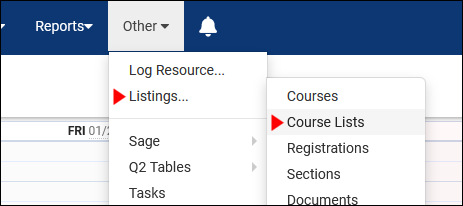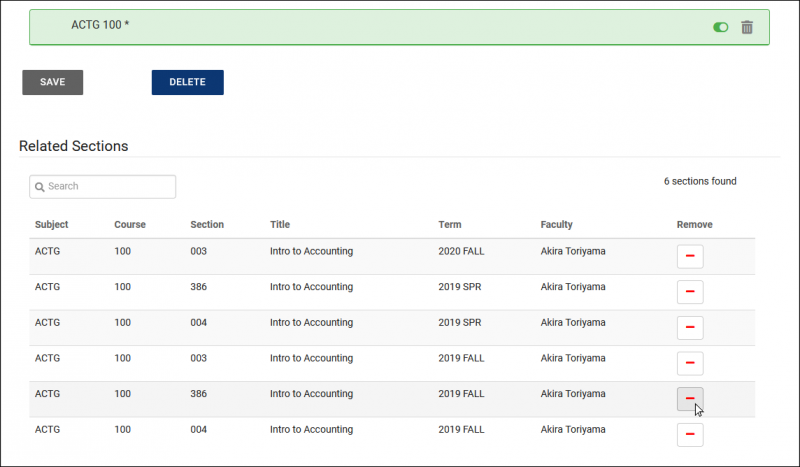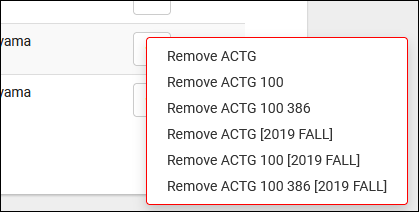|
|
Creating Course Lists
Course Lists act as assigned sections or specialties in TracCloud, allowing you to determine which courses each of your consultants can assist with, and which courses are available in each center.
Creating and Managing Course ListsTo manage your course lists, go to Other > Listings… > Course Lists.

This will bring you to the Course Lists listing.
File:K5775k56k64544jk.png
- Process Specialties allows you to re-scan for new courses that fall under the criteria of these lists. For example, if a list was created for Math 100 courses, but only sections 01 and 02 existed when it was created, you would need to re-scan to add the new 03 and 04 sections. This step is part of the TracCloud semester changeover process.
- The Hamburger Icon (File:Hamburger.png) allows you to show all course lists after a search, print the list, or create a new list. Go ahead and click “New Course List” to begin.
After selecting New Course List, we’re brought to the following page, allowing us to name and customize our new list.
File:46kj4k56kj54hrt.png
- Name will be what you’ll select when assigning this course list to your centers or consultants.
- Add New Course Item allows us to add a new subject query. We can be as specific as needed here, we can specify up to the Subject, Course Number, Section Number, or Term Number, as well as faculty. This allows us to create a course list of all MATH 101 courses, regardless of section/term, or all ACTG courses period.
- Each Course Item also has a toggle icon on the right-hand side, this allows us to include/exclude the queried course(s). For example, you could create a course list of all MATH courses, and then create another Course Item for MATH 204 and set the toggle icon to off. This would result in the list containing all MATH courses except for 204.
- Add Other Course List allows us to include/exclude the contents of an entire other course list.
As an example, we’re going to create a course list for one of our consultants. This consultant can assist with all Accounting 100 courses, except for section 386. Here’s how we would write that out.
To start off, we’re including all ACTG 100 courses, ignoring section (wildcard), term, and faculty.

At this point, we can manually add another entry for section 386 and click the toggle icon to exclude the course. Alternatively, we can scroll down to view the sections that will be included in this list, where we can see section 386. We can immediately exclude this course by clicking the remove icon on the right-hand side.

Clicking the icon prompts us to choose how specific we want to be with this exclusion. For our scenario, we would select “Remove ACTG 100 386.”

This will add the new item to the list automatically, excluded by default.

Assigning Centers to a Course ListCourse lists can be assigned to centers to determine which courses show up when users are creating availabilities or booking appointments, in addition to the individual consultants’ course lists. In your Center entry window, you will see the highlighted options below.
Other > Other Options > Profiles > [Your Profile] > Centers > [Your Center]
File:J64j4j54j4.png
- Ignore consultant specialties for this center
During the kiosk login or appointment booking process, students are asked what subject they need assistance with. When you select a consultant, the list of available subjects/reasons is restricted based on what the consultant is assigned to. By checking this box, these specialties are ignored, and a student can choose any subject/reason/consultant combination, only restricted by what’s assigned to the center itself. Typically used for writing centers.
- Course List for this Center
This setting controls the courses assigned to this center. If you have a Math center, you may want to assign a course list containing all Math and Accounting courses, for example.
|




